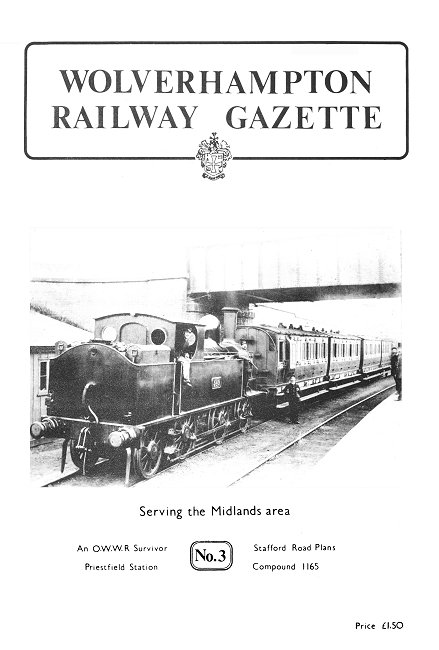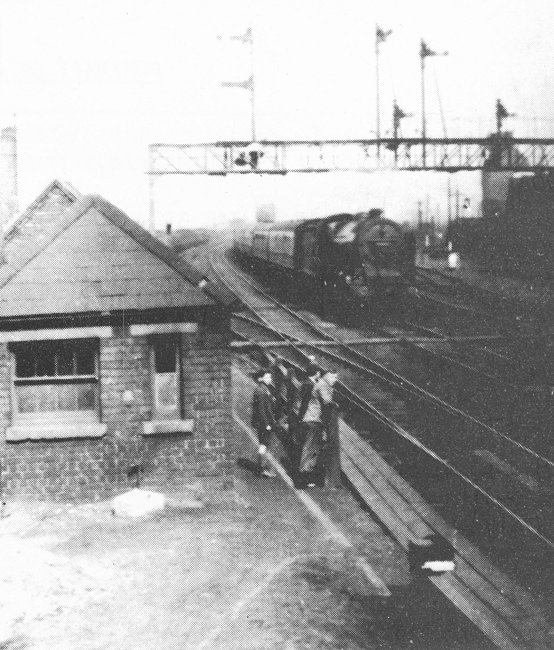The Third Edition
 |
This edition includes articles on local pannier tank
engines, the last surviving O.W.W.R. locomotive, 'Reminiscences of a
Bushbury train spotter', some local saddle tanks and a Webb coal tank, a
photograph and details of the 1929 Bushbury ambulance class, Priestfield
Station, Driver Jones and his engine, old engines at Stafford Road, 2
drawings of S & B locomotives and part 3 of the compilation of principal
events in Wolverhampton's railway history. Apart from interesting
articles, this edition includes some rare photographs. There is a
photograph of a Webb coal tank that was discovered by Jim Boulton, and a
couple of photographs of early engines at Stafford Road works.
The cover photograph is the late Jim Boulton's picture of a Webb coal tank at
Wellington. |
Reminiscences of a
Bushbury Train Spotter
By Alex Chatwin
| For the first twenty years of my life I lived within a few hundred
yards of Bushbury Sheds, and earliest recollections are of a continual
clanging and thumping from the shunting hump and the distinctive beat of
a L.N.W.R. 0-8-0 slogging up the bank towards the High Level. I was born into a railway family, my father and three of his brothers
being L.M.S. employees, and their father foreman for "Wagon Repairs Ltd"
in Bushbury Yard until his death in 1925. As a small boy in the early
1930s my chief interest lay in the activities of the Shed and I was
regularly chastised for arriving home filthy dirty from the grimy grass
which grew in the fields along Fordhouse Road and Showell Road. I soon
learned to distinguish the principal types of locomotive by colour and
shape and well remember peering through the fence on the bridge to see a
pair of standard compounds alongside the shed. At that time these
engines worked in pairs on the London expresses, but were replaced when
the rebuilt 'Claughtons' appeared as 'Patriots'.
I must have been about eight years of age when I started train spotting
as a regular hobby during the summer holidays. A group of boys collected
on the Showell Road side of the road bridge abutment, opposite the
signal box. This was before the factories were built on that side of the
road. From this point we had an excellent view of both lines to the
south and on a clear day could see the steam of engines in the, High
Level station. By the time an express reached Bushbury it was travelling
at full speed and the sight of a 'George' or a 'Prince' swaying and
rocking down the hill, its high pitched whistle screeching as it
approached, cannot be forgotten. Some of the names come back to me,
'Gallipoli', 'Racehorse' and 'Queen of the Belgians'. On the old Grand
Junction line speed was usually much slower, with trains being
frequently held up at the signal near Nine Elms Lane. Many of these were
the Bournville excursions usually hauled by a 2-6-0 'Crab'. Each evening
would appear over this line the Saltley Goods with a Midland 0-6-0 at
its head. These were of innumerable variety, and some had been rebuilt
several times. I was never able to remember the differences between the
permutations.
Although we had an unimpaired view of the lines to the south, we could
see nothing of trains travelling from the north, and could only wait as
the noise of each express increased until it burst into view under the
bridge. The most impressive of these trains was The 'Pines Express'
which ran from Manchester to Bournmouth each day, usually in several
parts. The first part usually with a 'Royal Scot' travelled over the
Grand Junction line to Birmingham and the second via the Stour Valley
line through Wolverhampton. More mundane happenings were the coal trains
supplying the Gas Works, and to a lesser extent the E.C.C. factory,
which were, pushed up the Down main line, to their respective spurs,
usually by one of the ancient Webb 0-6-0 goods engines stationed at
Bushbury.
Also from time to time would appear from under the bridge
a line of coal wagons bound for the G.W.R. junction line off
the Grand Junction line. These would be pushed by one of standard
0-6-0 tank engines called 'Jintys'.
|

A view from Bushbury railway bridge, taken
in 1952. The guards buildings an the left, sheds on the right. The
L. N. W. R. gantry has gone but the scene is otherwise unchanged
from the 1930s. No. 45500 'Patriot' passes at speed.
Photograph Mike Jones. |
Local trains to Stafford and Stoke were usually hauled by a
Fowler tank engine, small or large, although occasionally a
Precursor tank would be used.
The ubiquitous L.N.W.R. ‘D’ 0-8-0s
handled most of the goods trains but sometimes a demoted
'Claughton', original or rebuilt would appear.
A 'Patriot' took
the Camden Goods southwards each evening just after eight
o'clock.
The group of train spotters ranged in age from about
eight to twenty, and among the older boys there was much talk
about the exotic sights to be seen in places as far away as
Crewe and Toton. |
| There was also a sort of folk-lore about previous sightings at
Bushbury, such as the time the Great Western 'King George V' had
appeared travelling south, an obvious reference to its return from the
1925 Centenary Exhibition at Manchester. Other such tales concerned the
time when the northbound 'Pines Express' appeared several hours late
hauled by an 0-8-0, and the Brewood Show Specials to Four Ashes when all
sorts of aged motive power, even the Webb 0-6-0s were pressed into
passenger service. There were about half a dozen of these ancient
engines, out of use, stored in the coal sidings beyond the turntable.
They rusted away for several years and then disappeared, whether for
repair or breaking up I never knew. One summer evening there was great
excitement not only among the spotters but also among the railway
employees. The new 'Silver Jubilee' locomotive of Stanier design with
its taper boiler, had brought in one of the London expresses and was to
be on shed at Bushbury overnight. The new engine in its original black
and chrome livery was viewed by a crowd of boys of all ages from the
wall and fence of the yard in the field in Fordhouse Road. Photographs
were taken, where are they now? In spite of the new design we did not
know that the new class were poor steamers and it would be some time
before they could be improved to match the Patriots. As the 1930s progressed the 'Black 5s' appeared, at first without top
feed and then the tapered boilered 2-6-0s, efficient no doubt, but less
attractive than the Horwich design with its huge outside cylinders. The
tapered boilered tanks appeared to supplement the Fowlers, and
occasionally we saw the 2-8-0 freight engines which were to give such
excellent service overseas during the war. (I came across one on-shed at
Lydda in Israel in 1951).
One event which remains clear in my mind was being taken by my father
one Sunday lunchtime along Fordhouse Road to climb up on to the shunting
hump and look down on the mainline. In a few minutes, travelling north,
approached a strange sight, what was apparently a motor bus with flanged
wheels. This was the 'Micheline', a product of the French tyre company
Michelin. I have since found out that it was powered by a 27h.p. Panhard
and Lavassor sleeve valve petrol engine, and that the wheels
incorporated Michelin pneumatic tyres 910/125in, operating at 85
lb/square inch. The vehicle was on test in various parts of the country
and its appearance at Wolverhampton was on April 10th 1932, two days
before my sixth birthday.
Although my train spotting activities had ceased by 1939, I still took
an interest in the sheds, and recall seeing what was I believe the first
'Pacific' through Bushbury. One Saturday afternoon in 1941 the Scottish
expresses were being routed over the Grand Junction line because of a
bomb on the Trent Valley line, and I saw a 'Duchess' stop to pick up a
pilot driver in Bushbury yard.
Years later, I was told another war-time story by the late Mr. W.A.
Wells of the Electric Construction Co. A vital piece of switch-gear
produced by the company had to be aboard a ship waiting to sail from the
Clyde. Time was very short and it was obvious that only a passenger
train would arrive in time.
One of the old Southern Railway six wheeled parcel vans was procured,
and a Glasgow express stopped in Bushbury yard for it to be attached.
This practice was unorthodox to say the least, and the railway official
was duly "carpeted" for arranging such an unofficial stop, and not
following the correct procedure by sending the van to the High Level.
However, the end justified the means and the switchgear was shipped as
required.
It has all gone now, a whole way of life has disappeared and Bushbury
today is a very different place to the railway community I knew in the
1930s. I hope it will not be forgotten. |

|
|

|
|

|
| Return to
Edition 2 |
|
Return to
the Beginning |
|
Proceed to
Edition 4 |
|